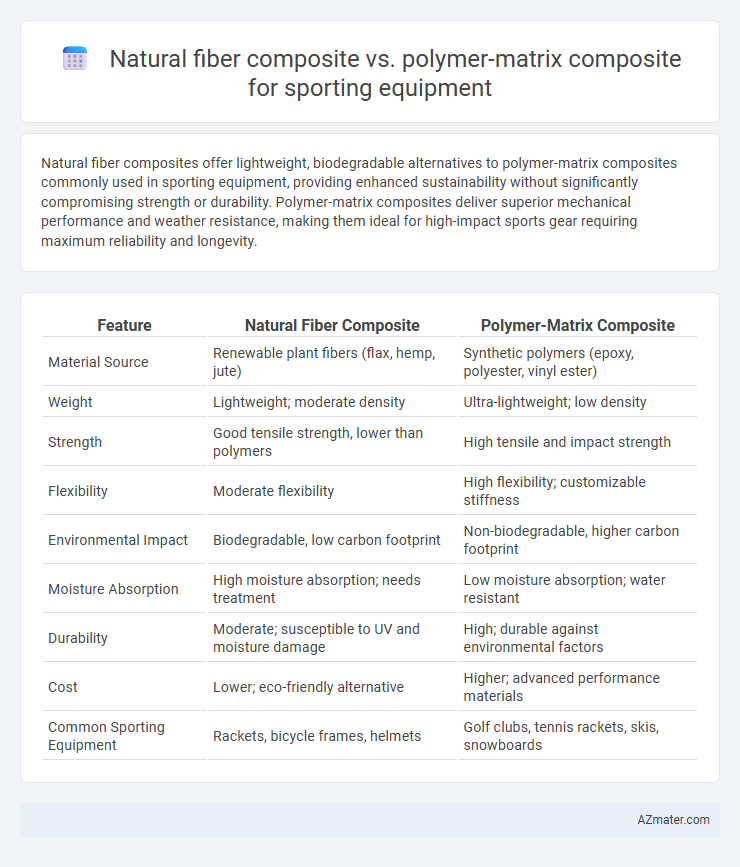Natural fiber composites offer lightweight, biodegradable alternatives to polymer-matrix composites commonly used in sporting equipment, providing enhanced sustainability without significantly compromising strength or durability. Polymer-matrix composites deliver superior mechanical performance and weather resistance, making them ideal for high-impact sports gear requiring maximum reliability and longevity.
Table of Comparison
| Feature | Natural Fiber Composite | Polymer-Matrix Composite |
|---|---|---|
| Material Source | Renewable plant fibers (flax, hemp, jute) | Synthetic polymers (epoxy, polyester, vinyl ester) |
| Weight | Lightweight; moderate density | Ultra-lightweight; low density |
| Strength | Good tensile strength, lower than polymers | High tensile and impact strength |
| Flexibility | Moderate flexibility | High flexibility; customizable stiffness |
| Environmental Impact | Biodegradable, low carbon footprint | Non-biodegradable, higher carbon footprint |
| Moisture Absorption | High moisture absorption; needs treatment | Low moisture absorption; water resistant |
| Durability | Moderate; susceptible to UV and moisture damage | High; durable against environmental factors |
| Cost | Lower; eco-friendly alternative | Higher; advanced performance materials |
| Common Sporting Equipment | Rackets, bicycle frames, helmets | Golf clubs, tennis rackets, skis, snowboards |
Introduction to Sporting Equipment Materials
Natural fiber composites in sporting equipment offer lightweight and eco-friendly alternatives to traditional materials, providing sufficient strength and impact resistance for applications like tennis rackets and bicycle frames. Polymer-matrix composites, commonly using carbon or glass fibers embedded in epoxy or polyester resins, deliver superior mechanical performance and durability required for high-performance gear such as golf clubs and hockey sticks. The choice between these materials depends on balancing factors like cost, weight, environmental impact, and mechanical properties specific to each sport's equipment demands.
Overview of Natural Fiber Composites
Natural fiber composites (NFCs) in sporting equipment utilize fibers like hemp, flax, and jute embedded in polymer matrices, offering lightweight and sustainable alternatives to traditional materials. These composites provide enhanced vibration damping, improved impact resistance, and reduced carbon footprint, making them ideal for eco-friendly sports gear such as paddles, rackets, and protective panels. NFCs balance mechanical performance with environmental benefits, supporting the growing demand for green materials in high-performance athletic applications.
Understanding Polymer-Matrix Composites
Polymer-matrix composites (PMCs) in sporting equipment consist of synthetic fibers such as carbon or glass embedded in a polymer resin, offering high strength-to-weight ratios and superior durability. These composites provide enhanced stiffness and impact resistance vital for performance in sports like tennis, cycling, and golf. Compared to natural fiber composites, PMCs deliver more consistent mechanical properties and better environmental resistance, making them ideal for high-performance applications.
Mechanical Properties Comparison
Natural fiber composites exhibit lower density and improved environmental sustainability compared to polymer-matrix composites, making them ideal for lightweight sporting equipment. Polymer-matrix composites typically offer superior tensile strength, impact resistance, and durability, essential for high-performance applications in sports like tennis rackets and bicycle frames. The mechanical properties of polymer composites surpass those of natural fiber alternatives in stiffness and fatigue resistance, although advancements in fiber treatment and hybridization are closing this performance gap.
Environmental Impact and Sustainability
Natural fiber composites in sporting equipment, such as those made from flax or hemp fibers, significantly reduce carbon footprint and enhance biodegradability compared to traditional polymer-matrix composites, which primarily rely on petroleum-based resins like epoxy or polyester. The renewable sourcing and lower energy consumption during production of natural fiber composites contribute to sustainability, while polymer-matrix composites pose challenges due to their long degradation times and difficulty in recycling. Innovations in bio-based resins are emerging to improve the environmental profile of polymer-matrix composites, but natural fiber composites currently offer superior ecological benefits in the sports industry.
Weight and Performance Analysis
Natural fiber composites in sporting equipment offer significantly lower weight compared to traditional polymer-matrix composites, enhancing athlete agility and endurance. Performance analysis indicates that while polymer-matrix composites provide superior strength and durability, natural fiber composites deliver adequate mechanical properties with improved sustainability and impact absorption. The trade-off between weight reduction and mechanical performance positions natural fiber composites as a promising alternative for lightweight, eco-friendly sports gear.
Durability and Longevity
Natural fiber composites in sporting equipment offer enhanced sustainability but typically exhibit lower durability and shorter longevity compared to polymer-matrix composites. Polymer-matrix composites, such as carbon fiber or fiberglass reinforced polymers, provide superior resistance to wear, impact, and environmental degradation, ensuring longer-lasting performance under intense athletic use. The choice between these materials balances eco-friendliness with the need for high strength and extended lifespan in demanding sports applications.
Cost and Manufacturing Considerations
Natural fiber composites offer a cost-effective alternative to polymer-matrix composites due to the lower raw material prices and reduced environmental processing requirements. Manufacturing natural fiber composites typically involves less energy-intensive methods and can utilize simpler equipment, which reduces overall production costs. However, polymer-matrix composites provide superior durability and performance consistency, often justifying their higher manufacturing expenses in high-performance sporting equipment applications.
Popular Sporting Equipment Applications
Natural fiber composites are increasingly used in sporting equipment such as tennis rackets, bicycle frames, and helmets due to their lightweight, eco-friendly properties, and good impact resistance. Polymer-matrix composites dominate in high-performance applications like golf club shafts, skis, and racing bicycles because of their superior strength, stiffness, and durability. The choice between natural fiber and polymer-matrix composites depends on performance requirements, sustainability goals, and cost considerations in the design of sporting goods.
Future Trends in Composite Materials for Sports
Natural fiber composites in sporting equipment are gaining traction due to their biodegradability, lightweight nature, and enhanced sustainability compared to traditional polymer-matrix composites, which offer superior mechanical strength and durability. Future trends indicate a significant shift towards hybrid composites that combine natural fibers with advanced polymers to optimize performance, reduce environmental impact, and incorporate smart materials for enhanced functionality. Innovations in nanotechnology and bio-based resins are expected to drive the development of next-generation sports gear with improved energy absorption, flexibility, and eco-friendly attributes.

Infographic: Natural fiber composite vs Polymer-matrix composite for Sporting equipment
 azmater.com
azmater.com